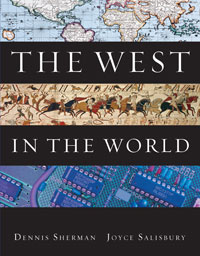 
The West in the World, 4th Edition (Sherman)Chapter 24:
Into the Fire Again: World War II, 1939-1945Critical Thinking Questions- The Road to War, 1931-1939
- In what ways did international affairs break down over the course of the 1930s?
- How and why did the Spanish civil war become an international battlefield?
- What ideas did Picasso convey in his painting, Guernica (1937)?
- How did the Western governments react to the increasingly tense international situation? Specifically, why did the British and French choose to pursue a policy of appeasement?
- Axis Victories, 1939-1942
- How did the Germans employ the tactic of blitzkrieg to win decisive victories early in the war?
- Winston Churchill warned his people, "this is no war of chieftains or of princes, of dynasties or national ambition; it is a war of peoples and of causes." How does his observation reflect the concept of a "total war"? How might Churchill's statement have been as much a rallying cry as a warning?
- How did Japanese ultra-nationalism contribute to its decision to attack the United States in 1941? How did this action induce the United States to enter the war?
- What was the reasoning behind Germany's decision to attack the Soviet Union in 1942?
- Behind the Lines: The Struggle and the Horror
- Who were the primary targets of Hitler's extermination programs during the Holocaust?
- How many Jews were murdered during the Holocaust and what was the primary method of execution?
- How did organized resistance groups in areas of German occupation frustrate the German war effort?
- Who was Tito and how did he mobilize resistance to Nazi occupation?
- What roles did women play in the mobilization of the home front?
- How does Elizabeth Hawes' experience in factory work compare with the removal of Japanese Americans from their homes and businesses, and the use of racist propaganda? Is there a conflict here?
- Turning the Tide of War, 1942-1945
- How did the Battle of Stalingrad help turn the tide of the war in the Allies' favor?
- How did the D-Day invasion of June 1944 put pressure on the Germans in Europe?
- How did the decision by the United States to drop the atomic bomb on Japan force the end of the war in the Pacific? What were other factors that led to this decision?
- Peace and the Legacy of War
- What was the main challenge facing political leaders and diplomats involved in the peace settlement?
- Which countries represented the key opponents in the disagreement over the fate of the Eastern European countries? What were the main factors of this disagreement?
- How had World War II been different from previous wars?
 |  |
|





